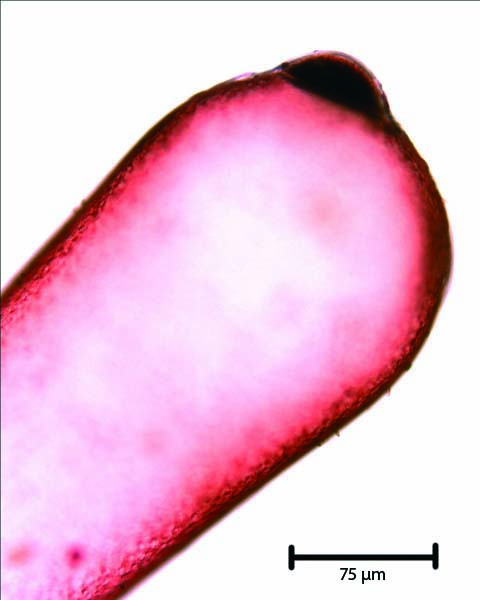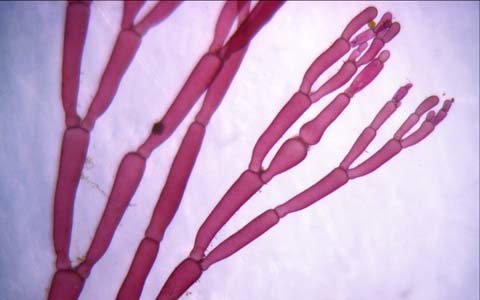
Morphology
|
||
Griffithsia pacifica can reach 5 cm tall in preferred habitats. The thalli are tufted and are usually orange-magenta in coloration. As seen on the left, photographed with a dissecting scope, branching is dichotomous in lower parts of the thallus and irregular in terminal portions due to ongoing development (1). This species has distinctive, turgid cylindroconical cells, which are easily visible with the naked eye. Individual cells can reach about 6.5 mm in length. |
||
 |
Budding The large, pink cell on the left is a terminal cell and is supporting the growth of a new cell at it's distal portion. The new cell looks globular at first, but then elongates into the characteristic cylindrical cell (by means of bipolar band growth, described in the "special" section). |
|
 |
Rhizoids Basal cells of this species are frequently entangled and produce rhizoids (1). In the picture, however, rhizoids began to develop from the distal portion of cells located on terminal thalli. The pictured specimen was kept in a water table, where the thalli were laying flat on the bottom; this rhizoidal growth is attributed to the plant's orientation. Becuase the plant was suspended horizontally, rhizoids developed at the newly assigned basal cells in search of a new place of attatchment. In contrast to the thallus, rhizoids are negatively phototropic, meaning that they grow away from a light source. This directional growth can be seen in the image, where all three rhizoidal formations are growing to the left (imagine the light source shining from the right). |
|
 |
Pit plugs Sometimes during cellular division, the cross wall septa don't connect, leaving an aperature in the center. When this occurs, endoplasmic reticlum lies across the aperature and material condenses, forming a pit plug (donut-shaped structure pictured to the left). The function of pit plugs is not completely understood, but it is thought that they function as a site of structural strength on the thallus (3).
Trivia: A study on the Griffithsia spp. showed that pit-plug composition is an acid polysaccharide-protein complex (2). |
References
1) Abbott, Isabella A. and George J. Hollenberg. Marine Algae of California. Stanford: Stanford University Press, 1976.
2) Bold, Harold C. and Michael J. Wynne. Introduction to the Algae. Englewood Cliffs: Prentice-Hall, Inc., 1978.
3) Lee, Robert Edward. Phycology. 3rd. Cambridge: Cambridge University Press, 1999.
